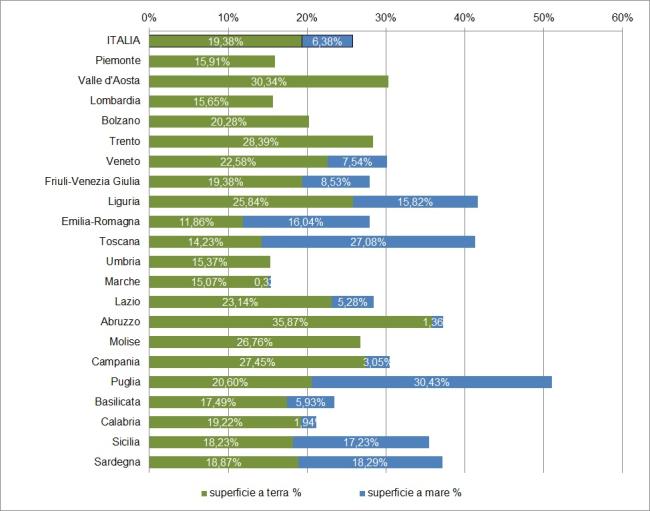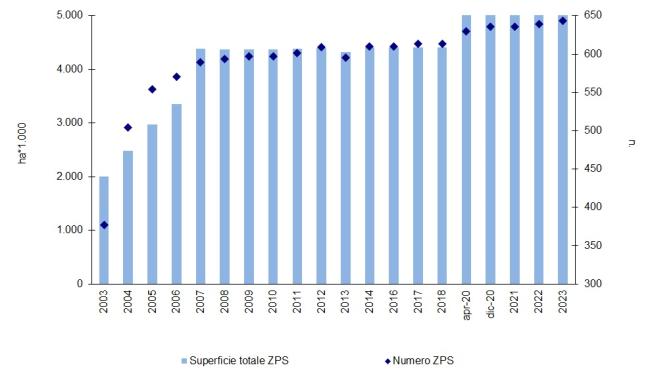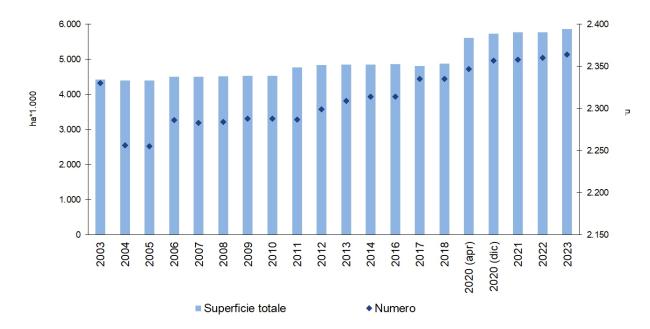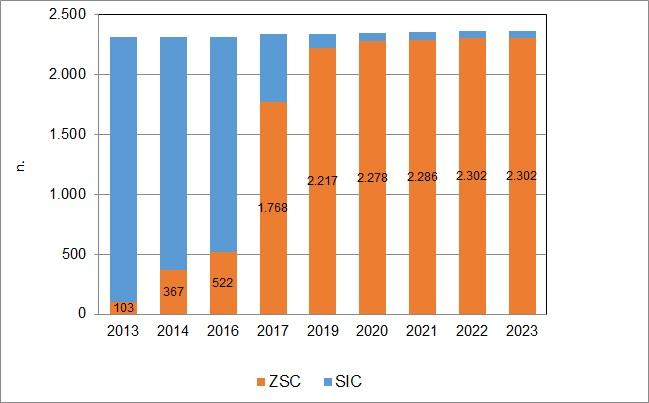Panel 1
Stefania Ercole
The Natura 2000 Network in Italy consists of 2,646 sites, covering a total area, net of overlaps, of 5,845,078 hectares on land, equivalent to 19.4% of the national territory, and 2,301,047 hectares at sea, corresponding to 6.4% of territorial waters (data updated to December 2023). A total of 643 Special Protection Areas (SPAs) and 2,364 Sites of Community Importance-Special Areas of Conservation (SCI-SACs) have been designated (of which 361 are SCI-SACs coinciding with SPAs). In December 2022, the sites numbered 2,639, with an increase of 7 units in the past year and an expansion of 163 hectares on land and 229,358 hectares at sea. The coverage percentages of the Natura 2000 Network vary across Italian regions and autonomous provinces, ranging from 12% to 36% on land and from less than 1% to 30% at sea.
The national coverage of the Network is significant in relation to the targets of the EU Biodiversity Strategy for 2030 (SEB2030), which calls for expanding protected areas in the EU to reach at least 30% of terrestrial and 30% of marine areas. The SEB2030 target includes all areas subject to protection measures, such as Natura 2000 sites, National and Regional Parks, and other protected areas. At the regional level, Abruzzo and Valle d’Aosta meet the SEB2030 target, with Natura 2000 sites covering 36% and 30% of their territories, respectively. Other regions approaching the target include the Autonomous Province of Trento (28%), Molise (27%), Campania (27%), and Liguria (26%). The protection percentages of Natura 2000 marine sites are lower, with only Puglia (30%) and Tuscany (27%) having protection levels close to the target.
This response indicator presents the extent and percentage coverage of the Natura 2000 Network at national and regional levels. It displays the number and surface area of Network sites in both terrestrial and marine environments. The data include Special Protection Areas (SPAs) established under the Birds Directive and Sites of Community Importance (SCI), later designated as Special Areas of Conservation (SACs) under the Habitats Directive. The indicator tracks progress in the implementation and definition of the Network from 2003 to the present, as well as advancements in the conversion of SCIs into SACs.
To assess the number and extent of SPAs and SCI-SACs at the national and regional levels, as well as the percentage of land and sea surface covered by the Natura 2000 Network as a whole.
The Natura 2000 Network is an ecological network for biodiversity conservation across the European Union, consisting of:
- Special Protection Areas (SPAs): Established by Member States under the Birds Directive 79/409/EEC (later repealed and fully replaced by Directive 2009/147/EC, which maintains its fundamental objectives). This was transposed into Italian law with Law No. 157 of February 11, 1992.
- Sites of Community Importance (SCIs): Identified under the Habitats Directive 92/43/EEC (transposed into Italian law by Presidential Decree 357/97, later amended and supplemented by Presidential Decree 120/2003) to ensure the long-term conservation of natural habitats and species of flora and fauna that are threatened or rare at the community level. These sites are subsequently designated as Special Areas of Conservation (SACs) as required by Article 4 of the Directive.
The Birds Directive aims to protect and manage all naturally occurring wild bird species in the European territory and regulates their exploitation. The Habitats Directive is designed to "safeguard biodiversity through the conservation of natural habitats and of wild flora and fauna in the European territory of the Member States to which the Treaty applies" (Article 2). To achieve this objective, it establishes measures to ensure the maintenance, or restoration, of a favorable conservation status for the habitats and species of Community interest listed in its annexes.
The Habitats Directive also sets regulations on site management and Appropriate Assessment (Article 6), funding (Article 8), monitoring and national reporting on the implementation of the Directive’s provisions (Articles 11 and 17), and the granting of possible exemptions (Article 16).
The general objective set by the relevant legislation is, therefore, to maintain a favorable conservation status for areas included in the Natura 2000 Network, which represent environments of great importance for habitats and animal and plant species, as well as for biodiversity conservation. The designation of SACs, as required by Article 4 of the Habitats Directive and Article 3, paragraph 2 of Presidential Decree 357/97 and subsequent amendments, is a crucial step in the full implementation of the Natura 2000 Network. It ensures the full application of site-specific conservation measures and provides greater security for the management of the network.
The national coverage of the Natura 2000 Network is also important in relation to the EU Biodiversity Strategy for 2030, which calls for expanding protected areas across the EU. Specifically, it mandates the protection of "at least 30% of terrestrial and 30% of marine areas, representing at least a 4% increase in land and a 19% increase in marine areas compared to today." Additionally, the strategy states that "at least one-third of the protected areas should be strictly protected, meaning at least 10% of the EU's land and 10% of its seas."
Panel 2
-
The indicator does not analyze the level of implementation of management tools within the Natura 2000 Network sites (management plans, conservation measures, etc.), nor the effectiveness of conservation actions.
-
Data quality assessment
MiTE (Ministry of Ecological Transition)
https://www.minambiente.it/pagina/sic-zsc-e-zps-italia
National
Regional 20/20
2003 – 2023
Indicator assessment
For each region or autonomous province, the following data are reported:
Number and surface area of SPAs, SCIs-SACs, and Type C sites (SCIs-SACs coinciding with SPAs).
The total surface area of the Natura 2000 Network (net surface area excluding overlaps).
The percentage of land and sea area covered by the Network, both regionally and nationally.
Additionally, the indicator tracks the evolution of the Network’s definition (in terms of surface area and number of sites) from 2003 to the present and monitors the progress of the designationprocess from SCIs to SACs.
As of today, the area protected under the Natura 2000 Network in Italy exceeds 5,800,000 hectares on land and 2,300,000 hectares at sea. The status can be considered good, given the extensive coverage of the Network, the advanced stage of transformation from SCIs to SACs (Figure 4), and the progress in defining its management tools. The expansion of protected areas within the Natura 2000 Network contributes to achieving the 30% target set by the SEB2030.
The trend is positive, as the expansion of the Natura 2000 Network has progressed from 2003 to the present, with an increase in protected surface area and the designation of new SPAs (Figure 2) and SCIs-SACs (Figure 3). A total of 2,646 sites, including SPAs and SCIs-SACs, have been designated (Table 1), with an increase of 7 sites in the last year (Dec. 2022 – Dec. 2023) and an expansion of 163 hectares on land and 229,358 hectares at sea. By the end of 2023, the total terrestrial area included in the Network was 5,845,078 hectares, while the marine area reached 2,301,047 hectares (Table 1), having nearly quadrupled since 2017.
Data
Tabella 1: Siti della Rete Natura 2000 per ogni Regione/Provincia Autonoma: numero totale, estensione totale in ettari e percentuale a terra e a mare, al netto delle eventuali sovrapposizioni fra i SIC-ZSC e le ZPS (agg. dicembre 2023)
MASE (https://www.mase.gov.it/pagina/sic-zsc-e-zps-italia)
simbolo " /" per le regioni e PA che non hanno territorio a mare
Nel 2023 alla lista delle Regioni e PA è stata aggiunta la categoria "Oltre le acque territoriali" per i relativi siti. La superficie del sito IT1201000 (Parco Nazionale del Gran Paradiso), ricadente in parte in Valle d'Aosta e in parte in Piemonte, è stata attribuita a ciascuna regione per la parte effettivamente ricadente nel proprio territorio. La superficie del sito IT7110128 (Parco Nazionale Gran Sasso-Monti della Laga) ricadente in Abruzzo, Lazio e Marche, è stata attribuita a ciascuna regione per la parte effettivamente ricadente nel proprio territorio.La superficie del sito IT7120132 (Parco Nazionale d'Abruzzo) ricadente in Abruzzo, Lazio e Molise, è stata attribuita a ciascuna regione per la parte effettivamente ricadente nel proprio territorio. Poichè i siti IT3230085, IT3230006 e IT3230089 cadono in parte in Veneto ed in parte in Friuli-Venezia Giulia, il calcolo delle superfici è stato effettuato attribuendo a ciascuna regione la parte di sito effettivamente ricadente nel proprio territorio. Numero ed estensione dei siti sono stati calcolati escludendo le sovrapposizioni fra i SIC-ZSC e le ZPS.
Tabella 2: Numero e estensione totale a terra e a mare in ettari e in percentuale rispetto al territorio complessivo regionale, rispettivamente delle ZPS, dei SIC-ZSC e dei siti di tipo C (SIC-ZSC coincidenti con ZPS) nelle regioni e province autonome (agg. dicembre 2023)
MASE (https://www.mase.gov.it/pagina/sic-zsc-e-zps-italia)
MASE (https://www.mase.gov.it/pagina/sic-zsc-e-zps-italia)
Nel 2023 alla lista delle Regioni e PA è stata aggiunta la categoria "Oltre le acque territoriali" per i relativi siti. La superficie del sito IT1201000 (Parco Nazionale del Gran Paradiso), ricadente in parte in Valle d'Aosta e in parte in Piemonte, è stata attribuita a ciascuna regione per la parte effettivamente ricadente nel proprio territorio. La superficie del sito IT7110128 (Parco Nazionale Gran Sasso-Monti della Laga) ricadente in Abruzzo, Lazio e Marche, è stata attribuita a ciascuna regione per la parte effettivamente ricadente nel proprio territorio. La superficie del sito IT7120132 (Parco Nazionale d'Abruzzo) ricadente in Abruzzo, Lazio e Molise, è stata attribuita a ciascuna regione per la parte effettivamente ricadente nel proprio territorio. Poiché i siti IT3230085, IT3230006 e IT3230089 cadono in parte in Veneto ed in parte in Friuli-Venezia Giulia, il calcolo delle superfici è stato effettuato attribuendo a ciascuna regione la parte di sito effettivamente ricadente nel proprio territorio.
Figura 1: Estensione percentuale a terra e a mare della Rete Natura 2000 per l'Italia e per ciascuna regione/provincia autonoma (agg. dicembre 2023)
Elaborazione ISPRA su dati MASE (https://www.mase.gov.it/pagina/sic-zsc-e-zps-italia)
Percentuali calcolate rispetto ai territori e alle acque regionali, al netto delle sovrapposizioni fra SIC-ZSC e ZPS. Nel grafico non sono rappresentati i 2 siti (17.004 ha pari al 0,08%) situati "oltre le acque territoriali". La superficie del sito IT1201000 (Parco Nazionale del Gran Paradiso), ricadente in parte in Valle d'Aosta e in parte in Piemonte, è stata attribuita a ciascuna Regione per la parte effettivamente ricadente nel proprio territorio. La superficie del sito IT7110128 (Parco Nazionale Gran Sasso-Monti della Laga) ricadente in Abruzzo, Lazio e Marche, è stata attribuita a ciascuna Regione per la parte effettivamente ricadente nel proprio territorio.La superficie del sito IT7120132 (Parco Nazionale d'Abruzzo) ricadente in Abruzzo, Lazio e Molise, è stata attribuita a ciascuna Regione per la parte effettivamente ricadente nel proprio territorio. Poichè i siti IT3230085, IT3230006 e IT3230089 cadono in parte in Veneto ed in parte in Friuli, il calcolo delle superfici è stato effettuato attribuendo a ciascuna Regione la parte di sito effettivamente ricadente nel proprio territorio. Numero ed estensione dei siti sono stati calcolati escludendo le sovrapposizioni fra i SIC-ZSC e le ZPS.
Figura 2: Numero e superficie totale annua (a terra e a mare) delle Zone di Protezione Speciale (ZPS) in Italia (agg. dicembre 2023)
Elaborazione ISPRA su dati MASE (https://www.mase.gov.it/pagina/sic-zsc-e-zps-italia)
Sono compresi nel computo anche i siti di tipo C (ZPS coincidenti con SIC-ZSC); non sono disponibili i dati del 2015 e del 2019
Figura 3: Numero e superficie totale annua (a terra e a mare) dei SIC-ZSC in Italia (agg. dicembre 2023)
Elaborazione ISPRA su dati MASE (https://www.mase.gov.it/pagina/sic-zsc-e-zps-italia)
Dal 2013 viene indicato il numero complessivo di SIC e ZSC. Sono compresi nel computo anche i siti di tipo C (SIC-ZSC coincidenti con ZPS). Non sono disponibili i dati del 2015 e del 2019




The Natura 2000 Network in Italy consists of 2,646 sites (Table 1), distributed across all Italian regions and autonomous provinces. A total of 282 SPAs (Special Protection Areas), 2,003 SCIs-SACs (Sites of Community Importance later designated as Special Areas of Conservation), and 361 type C sites (SCIs-SACs overlapping with SPAs) have been designated (Table 2), bringing the national total to 643 SPAs and 2,364 SCIs-SACs, both on land and at sea.
In 2023, new sites were established, leading to an increase in protected areas, primarily in marine environments (+229,358 hectares at sea compared to 2022). This aligns with the trend observed since 2017-2018, which has seen a significant expansion of the network, especially in marine areas. In December 2023, the Ministry of Environment and Energy Security (MASE) introduced the "Beyond Territorial Waters" category, referring to marine sites located outside territorial waters. Currently, two SCIs-SACs fall into this category, covering 17,004 hectares (0.08%). Additionally, the percentage of marine coverage within the Natura 2000 Network has been recalculated (Tables 1 and 2).
The total net protected area, excluding overlaps, amounts to 5,845,078 hectares on land (19.4% of the national territory) and 2,301,047 hectares at sea (6.4% of marine waters). These percentages are significant, especially in relation to the targets of the EU Biodiversity Strategy for 2030 (SEB2030), which requires Member States to protect at least 30% of both land and sea. It is important to note that this target also includes other protected areas such as National and Regional Parks. Moreover, Natura 2000 sites are sometimes fully or partially overlapping with these other protected areas.
The coverage percentages of the Network vary across Italian regions and autonomous provinces, ranging from 12% (Emilia-Romagna) to 36% (Abruzzo) for land areas and from less than 1% (Marche) to 30% (Puglia) for marine areas (Figure 1, Table 1).
At the regional level, Abruzzo (36%) and Valle d'Aosta (30%) have already achieved the SEB2030 target, while several other regions are approaching it, including the Autonomous Province of Trento (28%), Molise (27%), Campania (27%), and Liguria (26%). In marine areas, coverage percentages are generally lower, except for Puglia, which has already reached the 30% target, and Tuscany (27%), which is close to meeting it. However, the total regional protected area includes both the Natura 2000 Network and other protected areas. The regions that recorded an increase in the number of sites and protected surface area from 2022 to 2023 are Friuli-Venezia Giulia, Liguria, Puglia, and Basilicata. Furthermore, two new sites located beyond territorial waters have been added to the network.